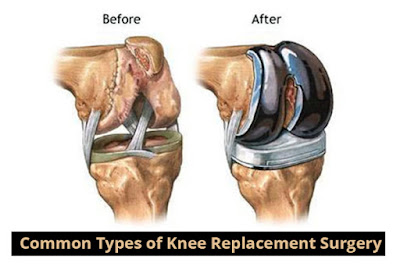Common Types of Knee Replacement Surgery
What
is the Knee?
The
knee is the largest joint in our body. It is comprised of the lower
leg bone, the thigh bone and the knee cap as well as multiple
tendons, ligaments, muscles and cartilage that connect at the knee. It
is responsible for supporting most of our body weight, making it
susceptible to various types of injury and damage.
If
you have a painful knee condition like knee does not respond well to
conservative treatment,
there are various knee surgery options available to you, depending on
the knee injury.
Click
on below Video: Knee Pain
What is Knee Replacement Surgery?
Knee
surgery is used for the treatment of different
conditions that can cause knee pain and injury. While non-surgical
treatments are often attempted for the initial treatment, there are
situations where knee surgery becomes necessary or recommended
treatment. Let's have a look at different types of knee surgery and
the conditions that are best treated with each.
Click
on below Video: Knee Pain Exercises
Different Types of Knee Replacement Surgery
Some
of the more different types of knee surgeries. Hopefully, you won't
have to have any of these, but if you do, the good news is that with
today's technology and experience, we have got you covered. There are
many hospitals for knee replacement surgery in Mumbai, India where
they use the latest technology to perform surgery and the cost is
quite low.
1.
Total Knee Replacement
A
person who has severe arthritis in the knee requires a total knee
replacement as opposed to a partial knee replacement. A surgeon can
assist with the appropriate selection of an artificial knee
replacement.
Click
on below video: Total Knee Replacement Surgery
2.
Lateral Release
A
lateral release is a type of knee replacement surgery that is used to
relieve pain in the kneecap caused when the kneecap is abnormally
pulled in the outer direction of its groove. This is another
arthroscopic procedure and realigns the kneecap.
3.
Meniscectomy
Meniscectomy
knee replacement surgery is used when a part of the knee's cartilage
called the meniscus is causing pain, damaged, swelling and problems
with movement. The common form of a Meniscectomy is arthroscopy. In
arthroscopic knee surgery, small incisions are made around the knee
for the insertion of a small camera and other instruments that are
needed to remove the damaged meniscus safely.
4.
Meniscus Repair
In
some cases of the injured meniscus, it is possible to repair the
cartilage rather than remove it completely. The meniscus is the type
of knee replacement surgery which is more beneficial to the patient
than complete removal as it reduces the risk of developing arthritis
later in future. Repair surgery is only feasible when the damage is
on the outer portion of the meniscus. If it is towards the inner area
of the cartilage, the lack of blood supply will not allow the
meniscus to heal itself after repair.
5.
Unicompartmental Knee Replacement Surgery
Unicompartmental
knee replacement surgery is an option for a small percentage of
patients who have diagnosed with osteoarthritis that is limited to
only one area of the knee. The procedure requires the damaged part of
the knee to be replaced with plastic and metal components. The
benefits of partial knee replacement surgery over a total knee
replacement surgery include:
-
Smaller incision
-
Less loss of blood
-
Faster recovery
-
Less complicated procedure
-
Feels more natural because just a portion of the knee is artificial
Click
on below video: Stages of Knee Osteorthritis
6.
Meniscus Transplant
A
meniscus transplant is knee replacement surgery for a damaged
meniscus that also uses arthroscopy. For this type of knee surgery, a
damaged meniscus is replaced with cartilage from a donor. Just like
meniscus repair surgery, this procedure is also beneficial because it
reduces the risk of knee pain and arthritis in the future.
7.
Microfracture Surgery
Microfracture
surgery is performed to repair damaged
cartilage. This type of surgery has been popularized by professional
athletes and is used to heal knee pain caused by cartilage damage or
to avoid a full knee replacement. This surgery is an arthroscopic
procedure where tiny holes are made in the bone. These holes help to
release cells in the bone and promote a better blood supply to
stimulate the cartilage growth to replace damaged cartilage.

Comments
Post a Comment